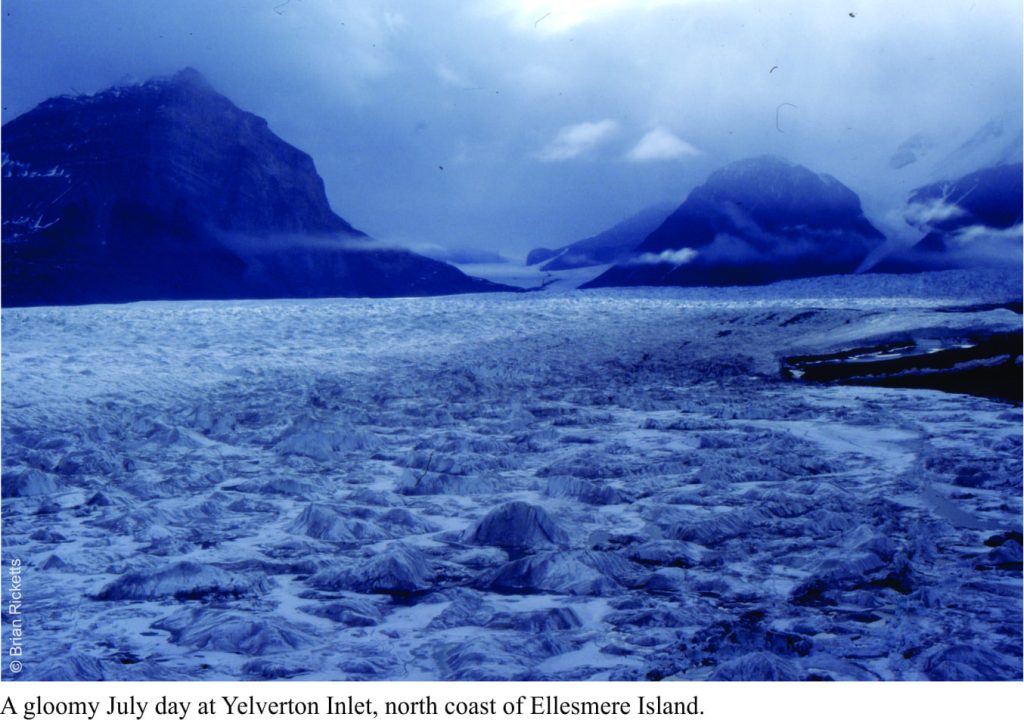This post is about asymmetry – the Arctic and Antarctic polar regions. They are the most frigid places on Earth, but that is about all they have in common; with one other exception – they are both stunningly beautiful. I can attest to this for the Arctic, or at least the Canadian Arctic Islands where I spent several summers; but I’ve never been to Antarctica. Visual treats everywhere. And silence – above the wind and the hum of a few insects – silence.
There is an intriguing asymmetry in their respective geographies, the timing of ice accumulation, present climates, the flora and fauna. What follows are a few comparisons and contrasts.
Geography The Arctic Ocean is surrounded by land, although it is not land-locked; bordering coastlines are part of Canada, USA (Alaska), Russia, and Greenland. The Canadian, Alaskan and Russian coastal regions above the Arctic Circle (currently 66°33′46.9″N), are mostly ice-free during summer months, are drained by rivers, sport some of the largest deltas in the world (e.g. MacKenzie Delta, Lena Delta), support extensive, albeit stunted forests of spruce and a diversity of wildlife, and people. Permanent human populations north of 66.5oN number in the millions; there are no permanent dwellers in the Antipodean equivalent (but there are scattered scientific establishments). NB The Arctic Circle is moving north at about 15m/year because the earth’s tilt moves about 3o over a 41,000 year cycle known as Obliquity.
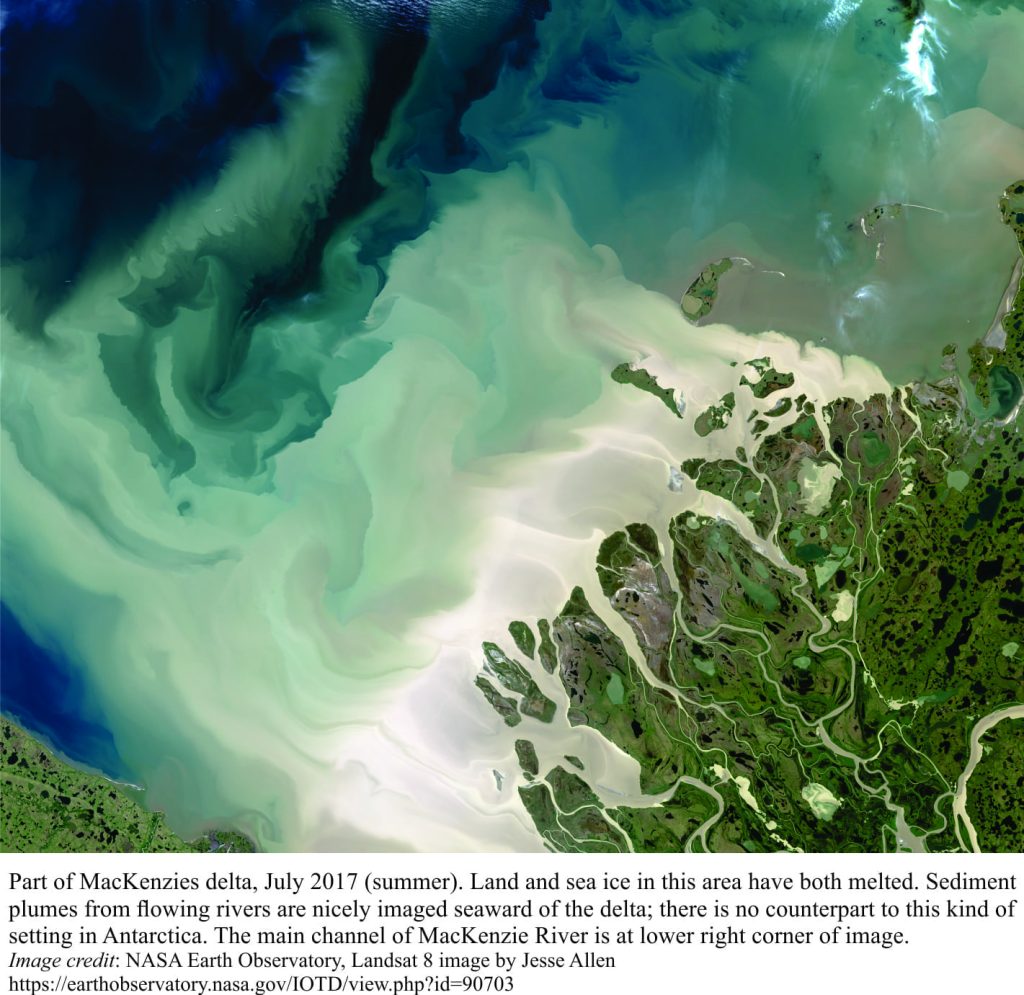 Antarctica is a continent surrounded by deep oceans; the closest landfall is Tierra del Fuego (South America), about 1000km from the tip of Antarctic Peninsula. Beneath the ice are some of the oldest rocks on earth, and some of the youngest. Antarctica was once part of the supercontinent, Gondwanaland. For example, during the Permian there were vast areas of swamp and forests of ferns, and to about 70 million years ago, dinosaurs. Now, there’s not a tree in sight and barely a blade of grass.
Antarctica is a continent surrounded by deep oceans; the closest landfall is Tierra del Fuego (South America), about 1000km from the tip of Antarctic Peninsula. Beneath the ice are some of the oldest rocks on earth, and some of the youngest. Antarctica was once part of the supercontinent, Gondwanaland. For example, during the Permian there were vast areas of swamp and forests of ferns, and to about 70 million years ago, dinosaurs. Now, there’s not a tree in sight and barely a blade of grass.
Arctic sea ice is limited by land, and cannot extend as far south as Antarctic ice can extend north. Antarctic therefore tends to lose more sea ice during the summer because it has extended to lower latitudes. Arctic sea ice also covers the North Pole, whereas the South pole is underlain by rocky crust (beneath the ice).
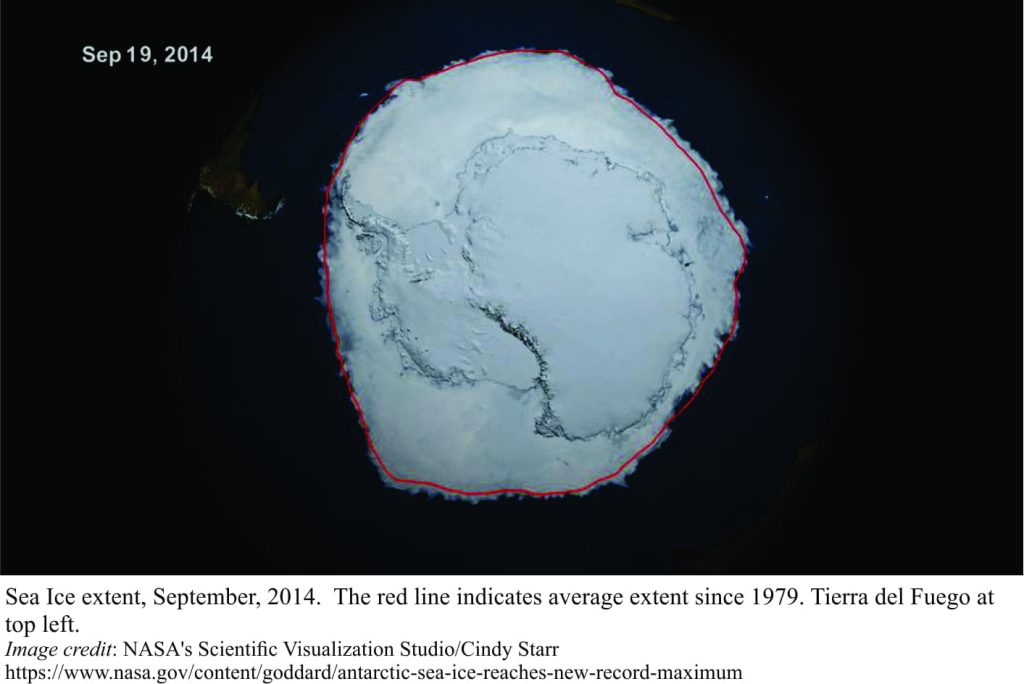 The Antarctic and Greenland ice sheets account for 99% of the world’s freshwater ice; the Antarctic ice sheet alone about 88%. In some ways it is easier to think of the relative volumes of ice in terms of a hypothetical rise in sea level if all the ice melted (note that sea ice does not contribute to a change in ocean water volumes or sea level). If both ice sheets melted, the average rise would be about 65 m, of which Antarctica would contribute 58 m.
The Antarctic and Greenland ice sheets account for 99% of the world’s freshwater ice; the Antarctic ice sheet alone about 88%. In some ways it is easier to think of the relative volumes of ice in terms of a hypothetical rise in sea level if all the ice melted (note that sea ice does not contribute to a change in ocean water volumes or sea level). If both ice sheets melted, the average rise would be about 65 m, of which Antarctica would contribute 58 m.
The beginning of polar ice Antarctic cooling has been linked to opening of Drake Passage, when it finally separated from the South American continent, possibly as long ago as 40-50 million years. The connection between the Atlantic and the Pacific oceans allowed the transfer of water, preventing warmer, tropical waters from moving south. Prior to about 34 million years ago, Antarctic was forested. Evidence from deep sea cores indicates that cooling began around this time and proceeded relatively rapidly. Accumulation of Antarctic ice-sheets was probably well under way by about 14 million years ago.
Reports, based on microfossils extracted from sediment core beneath Lomonosov Sea, push the Arctic sea ice pack as far back as 47 million years, although coastal areas may have been free of ice until 4 million years ago. Notably, the climate on land, at least in the Canadian Arctic islands, seems to have been quite different, with cool-temperate forests that teemed with life (including snakes, reptiles), at least till 40-45 million years ago. Prior to 4 million years ago, Arctic sea ice may have been of more limited extent. There is no evidence for permanent ice on land at that time.
Ice has covered parts of Greenland for at least 18 million years. Evidence for this is seen in ice-rafted sediment recovered from deep sea cores. However, the amount of ice has waxed and waned over the millennia. The oldest cored ice, at a cored depth of about 3000 m, is about 1 million years old.
Present Climate Average Arctic temperatures range from 0o to -34oC in winter, dipping to -50oC on occasion. In summer the temperatures skyrocket to a balmy -10 to +10C; in sheltered valleys it’s T-shirt weather. Arctic temperatures, unlike the Antarctic, are ameliorated by the ocean. Precipitation is highly variable and occurs as rain and snow. For example, the regions covering much of Ellesmere and Axel Heiberg Islands are basically desert, receiving less than 150mm/year. However, some parts of Greenland get more than 1000mm/year.
Antarctica is the continuously coldest place on Earth. The mean annual temperature of interior Antarctica is -57oC; the coldest recorded winter (thermometer) temperature is -89.2oC at Vostok Station (cold enough to form dry ice, or carbon dioxide ice, at 78.5oC). Coastal regions tend to be a bit warmer, although commonly still below zero centigrade. Precipitation here, almost entirely as snow, is less than 160mm, and like parts of the Arctic, are basically desert conditions. The Dry Valleys are both cold and arid, usually receiving less than 100mm/year precipitation.
Things that live there Animal life in the Arctic is diverse, and includes migratory and permanent species. Common animals in the high Arctic include: Polar Bears, Arctic Wolves, Arctic Foxes, Arctic Hares, Caribou, Reindeer, Lemmings, and Muskox.
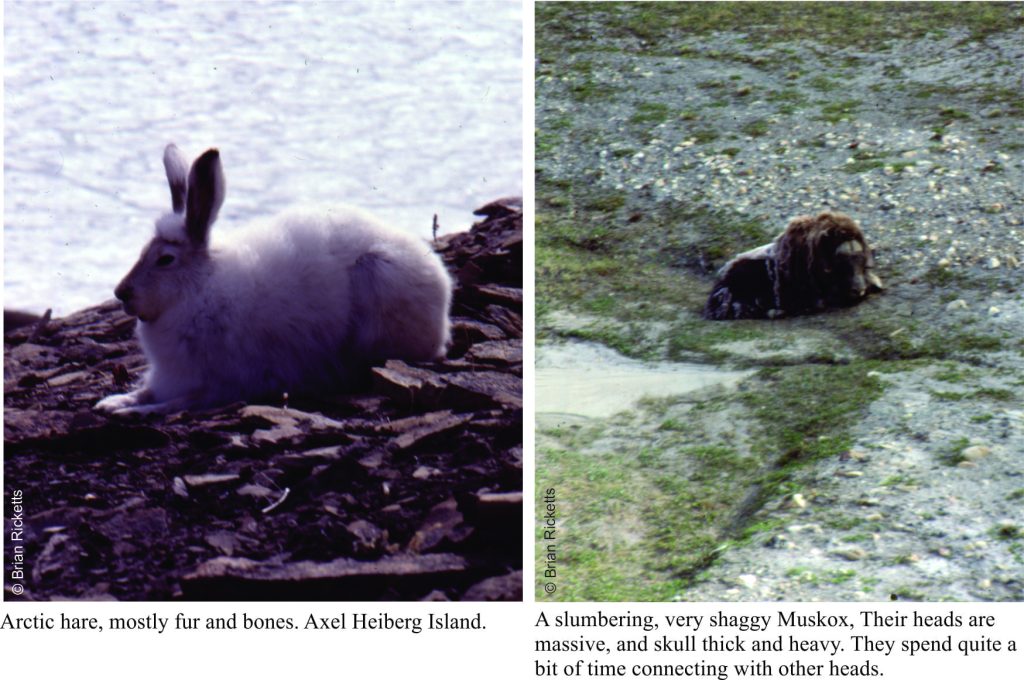 Marine mammals such as whales (Orca, Beluga), Narwhals, seals and walruses are relatively common. Seabirds like Snow Goose, Skua and Tern are common in coastal areas, Snowy Owls less so.
Marine mammals such as whales (Orca, Beluga), Narwhals, seals and walruses are relatively common. Seabirds like Snow Goose, Skua and Tern are common in coastal areas, Snowy Owls less so.
Plant life is also diverse, even above the tree-line. June and July in the Canadian Arctic Islands feature a glorious display of Arctic flowers, grasses, lichens and mosses, that are home to countless mosquitoes and various other bug annoyances. The flora is also an important part of the food chain for Caribou, Muskox, Hare and Lemmings.
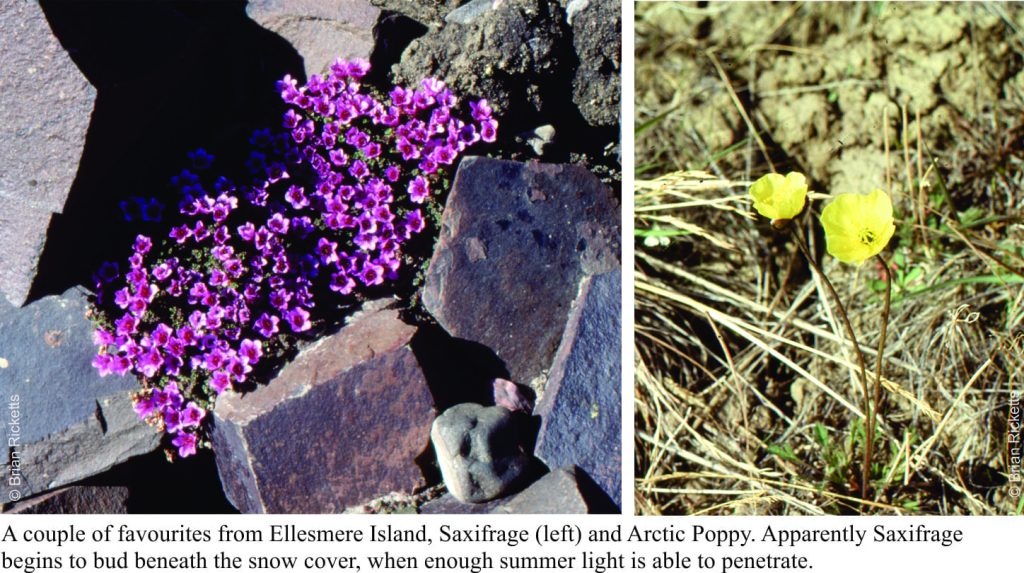 Life in Antarctica couldn’t be more different – it is concentrated along the coasts; Penguins are the only animals that spend appreciable time ashore or on winter ice around Antarctica. They share the coastal marine waters with several species of whales, seals, and other birds. Only two species of flowering plants are known on Antarctic Peninsula and some sub-Antarctic islands; Hair Grass, and Antarctic Pearlwort. Both are found in coastal regions along with non-vascular plants like mosses, lichens and liverworts.
Life in Antarctica couldn’t be more different – it is concentrated along the coasts; Penguins are the only animals that spend appreciable time ashore or on winter ice around Antarctica. They share the coastal marine waters with several species of whales, seals, and other birds. Only two species of flowering plants are known on Antarctic Peninsula and some sub-Antarctic islands; Hair Grass, and Antarctic Pearlwort. Both are found in coastal regions along with non-vascular plants like mosses, lichens and liverworts.
Political No one ‘owns’ Antarctica. Instead it is divided into Sectors that are administered by nations (Argentina, Australia, Chile, France, New Zealand, Norway and the United Kingdom); most have scientific bases and weather stations. The Antarctic Treaty, that come into force in 1961, established a rule of “Peaceful Use”. Currently there are 53 country signatories. More recently, about 1.6 million square kilometres of the Ross Sea (almost a third of the Sea area) was declared a Marine Reserve.
Land bordering the Arctic Ocean, plus large swaths of the sea bed, are sovereign territory, or at least are claimed as such. Offshore boundaries are governed by the Law of The Sea, although several claims are disputed – an excellent map, compiled by Durham University, shows disputed and undisputed boundaries.
********************
Antarctica is the only continent on which there has never been a war. Most countries seem to think that it is a good idea to maintain this status quo! Let’s hope that common sense continues to govern international and environmental relationships here, and in its antipode.
